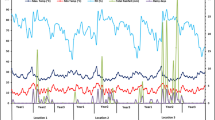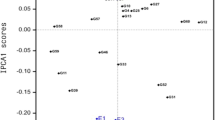Abstract
Ascochyta blight (caused by Ascochyta rabiei (Pass.) Labr.) is the most crucial limiting variable for decreasing yield levels of chickpeas around the world. A set of 20 diverse chickpea genotypes comprising advanced breeding lines and released varieties was evaluated, together with susceptible controls, for resistance to ascochyta blight for three continuous years under field conditions in three distinct chickpea-growing environments in Turkey. ANOVA and GGE biplot analysis were used to determine the response of each genotype to disease. Analysis results showed that most of the variation in ascochyta blight in both winter and spring sowings (39.99% and 40.61%) is due to the year, followed by G (17.01%) and Y × G interactions (12.69%) at winter sowing, and followed by Y × G (17.48%) and Genotype (16.60%) at spring sowing, which confirmed the requirement for multi-year, and multi-location testing. The GGE biplot analysis explained 73.31% of the total variation. The GGE biplot analysis of the tested environment and genotypes revealed that the nine test environments comprised three mega environments, and the genotypes were located in six different sectoral areas. The GGE biplot visually demonstrated the resistance and stability of chickpea genotypes to ascochyta blight. Arda was the most desirable genotype with the lowest disease scale in all test environments. This was followed by genotype G12 and the Azkan cultivar, respectively. It would be useful to use these resistant genotypes as stable resistance donors in chickpea breeding programs, to develop varieties resistant to Ascochyta blight.





Similar content being viewed by others
References
Aghamiri, A., Mehrabi, R., & Talebi, R. (2015). Genetic diversity of Pyrenophera tritici-repentis isolates, the causal agent of wheat tan spot disease from Northern Iran. Iranian Journal of Biotechnology, 13(2), e1118.
Akcura, M., Akan, K., & Hocaoglu, O. (2017). Biplot Analysis of Leaf Rust Resistance in Pure Lınes Selected From Eastern Anatolıan Bread Wheat Landraces of Turkey. Turkish Journal of Field Crops, 22(2), 227–234.
Atik, O., Ahmed, S., Abang, M. M., Imtiaz, M., Hamwieh, A., & Baum, M. (2013). Pathogenic and genetic diversity of Didymella rabiei affecting chickpea in Syria. Crop Protection, 46, 70–79.
Bar, I., Sambasivam, P. T., Davidson, J., Farfan-Caceres, L. M., Lee, R. C., Hobson, K., Moore, K., & Ford, R. (2021). Current population structure and pathogenicity patterns of Ascochyta rabiei in Australia. Microbial Genomics, 7(7), 000627. https://doi.org/10.1099/mgen.0.000627
Basandrai, A. K., Basandrai, D., Pande, S., Sharma, M., Thakur, S. K., & Thakur, H. L. (2007). Development of Ascochyta blight (Ascochyta rabiei) in chickpea as affected by host plant resistance and plant age. European Journal of Plant Pathology, 119, 77–86.
Bayraktar, H., Dolar, F. S., & Maden, S. (2007). Mating Type Groups of Ascochyta rabiei (Teleomorph: Didymella rabiei), the Causal Agent of Chickpea Blight in Central Anatolia. Turkish Journal of Agriculture and Forestry, 31, 4146.
Chen, W., Coyne, C. J., Peever, T. L., & Muehlbauer, F. J. (2004). Characterization of chickpea differentials for pathogenicity assay of ascochyta blight and identification of Chickpea accessions resistant to Didymella rabiei. Plant Pathology, 53, 759–769.
Farahani, S., Talebi, R., Maleki, M., Mehrabi, R., & Kanouni, H. (2019). Pathogenic diversity of Ascochyta rabiei isolates and identification of resistance sources in core collection of chickpea germplasm. Plant Pathology Journal, 35(4), 321–329.
Gowen, S. R., Orton, M., Thurley, B., & White, A. (1989). Variation in pathogenicity of Ascochyta rabiei on chickpeas. International Journal of Pest Management, 35, 180–186.
Iqbal, S., Ghafoor, A., Ayub, N., & Ahmad, Z. (2004). Pathogenic diversity in Ascochyta rabiei isolates collected from Pakistan. Pakistan J. of Bot., 36, 429–437.
Jukanti, A. K., Gaur, P. M., Gowda, C. L. L., & Chibbar, R. N. (2012). Nutritional quality and health benefits of chickpea (Cicer arietinum L.): A review. British Journal of Nutrition, 108, S12–S26.
Kadariya, M., Glove,r K. D., Mergoum, M., Osborne, L. E. (2008). Biplot analysis of agronomic and Fusarium head blight resistance traits in spring wheat. Journal of Crop Improvement, 22(2), 147–70.
Kaur, L., Singh, V. P., & Sandhu, J. S. (2012). Characterisation o f Ascochyta rabiei isolates and evaluation o f genotypic stability in chickpea. Arch Phytopathol Plant Prot, 45(1), 83–89.
Lillemo, M., Singh, R. P., Ginkel, M. V. (2010). Identification of stable resistance to powdery mildew in wheat based on parametric and non-parametric methods. Crop Science, 50(2):478–85. https://doi.org/10.2135/cropsci2009.03.0116
Madden, L. V., Paul, P. A., & Lipps, P. E. (2007). Consideration of nonparametric approaches for assessing genotype-by-environment (G×E) interaction with disease severity data. Plant Disease, 91, 891–900.
Mawar, R., & Banyal, D. K. (2017). Influence of sowing time on efficiency of chemical and biological management of anthracnose of cowpea. Indian Phytopath, 70(2), 262–264. https://doi.org/10.24838/ip.2017.v70.i2.70758
Montakhabi, M. K., ShahidiBonjar, G. H., & Talebi, R. (2020). Mating type profiling and SSR-based genetic diversity analysis of Iranian Fusarium oxysporum f. sp. ciceris causing wilt in chickpea. International Journal of Agriculture & Biology, 23, 1101–1106.
Naroui Rad, M. R., Abdul Kadir, M., Rafii, M. Y., Jaafar, H. Z. E., & Daaee, M. (2013). Gene action for physiological parameters and use of relative water content (RWC) for selection of tolerant and high yield genotypes in F2 population of wheat. Australian Journal of Crop Science, 7(3), 407–413.
Pande, S., Sharma, M., Gaur, P. M., Tripathi, S., Kaur, L., Basandarai, A., Khan, T., Gowda, C. L. L., & Siddique, K. H. M. (2011). Development of screening techniques and identification of new sources of resistance to Ascochyta blight disease of chickpea. Australasian Plant Pathology, 40, 149–215.
Pande, S., Sharma, M., Gaur, P. M., Basandrai, A. K., Kaur, L., Hooda, K. S., Basandrai, D., Kiran, T., Babu, S., Jain, K., & Rathore, A. (2013). Biplot analysis of genotype × environment interactions and identification of stable sources of resistance to Ascochyta blight in chickpea (Cicer arietinum L.). Australasian Plant Pathology, 42, 561–571.
Reddy, M. V., & Singh, K. B. (1984). Evaluation of a world collection of chickpea germ plasm accessions for resistance to ascochyta blight. Plant Disease, 68, 900–901.
Rubiales, D., Avila, C. M., Sillero, J. C., Hybl, M., Narits, L., Sass, O., & Flores, F. (2012). Identification and multi-environment validation of resistance to Ascochyta fabae in faba bean (Vicia faba). Field Crops Research, 126, 165–170.
Sandhu, P. S., Brar, K. S., Chauhan, J. S., Meena, P. D., Awasthi, R. P., Rathi, A. S., Kumar, A., Gupta, J. C., Kolte, S. J., & Manhas, S. S. (2015). Host–pathogen interactions of Brassica genotypes for white rust (Albugo candida) disease severity under aided epiphytotic conditions in India. Phytoparasitica, 43, 197–207.
Sharma, M. (2016). Ghosh R (2016) An Update on Genetic Resistance of Chickpea to Ascochyta Blight. Agronomy, 6(1), 18. https://doi.org/10.3390/agronomy6010018
Sharma, M., Kiran Babu, T., Gaur, P. M., Ghosh, R., Rameshwar, T., Chaudhary, R. G., Upadhyay, J. P., Gupta, O., Saxena, D. R., Kaur, L., Dubey, S. C., Anandani, V. P., Harer, P. N., & Pande, S. (2012a). Identification and multi-environment validation of resistance to Fusarium oxysporum f. sp. ciceris in chickpea. Field Crops Research, 135, 82–88.
Sharma, M., Kiran Babu, T., Gaur, P. M., Ghosh, R., Rameshwar, T., & Chaudhary, R. G. (2012b). Identification and multi-environment validation of resistance to Fusarium oxysprum f. sp. ciceris in chickpea. Field Crops Research, 135, 82–88.
Sharma, M., Telangre, R., Ghosh, R., Pande, S. (2015). Multi-environment field testing to identify broad, stable resistance to sterility mosaic disease of pigeon pea. Journal of General Plant Pathology, 81, 249–59.
Sharma, M., Ghosh, R., Telangre, R., Rathore, A., Saifulla, M., Mahalinga, D. M., & Jain, Y. K. (2016). Environmental influences on pigeonpea-Fusarium udum interactions and stability of genotypes to Fusarium Wilt. Frontiers in Plant Science, 7, 1–10.
Sibiya, J., Tongoona, P., Derera, J., & Rij, N. V. (2012). Genetic analysis and genotype by environment (G × E) for grey leaf spot disease resistance in elite African maize (Zea mays L.) germplasm. Euphytica, 185, 349–362.
Singh, K. B., Malhotra, R. S., & Saxena, M. C. (1997). Bejiga G (1997) Superiority of winter sowing over traditional spring sowing of chickpea in the Mediterranean region. Agronomy Journal, 89, 112–118.
Toker, C., Uzun, B., & Cagirgan, M. I. (1999). Screening and selection for resistance to ascochyta blight [Ascochyta rabiei (Pass.) Labr.] of chickpea (Cicer arietinum L.) under field conditions. Journal of Turkish Phytopathology, 28, 101–110.
Türkkan, M., & Dolar, F. (2009). Determination of pathogenic variability of Didymella rabiei, the agent of ascochyta blight of chickpea in Turkey. Turkish Journal of Agriculture and Forestry, 33(6), 585–591. https://doi.org/10.3906/tar-0901-34
Vail, S. S., & Banniza, S. (2009). Molecular variability and mating-type of Ascochyta rabiei of chickpea from Saskatchewan, Canada. Australasian Plant Pathology, 38, 392–398.
Yan, W. (2002). Singular-value partitioning in biplot analysis of multi-environment trial data. Agronomy Journal, 94(5), 990–996.
Yan, W., & Kang, M. S. (2003). GGE biplot analysis: A graphical tool for breeders, geneticists, and agronomists. CRC Press.
Yan, W., & Tinker, N. A. (2006). Biplot analysis of multi-environment trial data: Principles and applications. Canadian Journal of Plant Science, 86, 623–645.
Acknowledgements
This work was funded by General Directorate of Agricultural Research and Policies (TAGEM), Turkey, under Southeastern Anatolia Region Chickpea Breeding Research.
Author information
Authors and Affiliations
Corresponding author
Ethics declarations
Conflict of interest
The authors declare that they have no conflict of interest.
Rights and permissions
Springer Nature or its licensor (e.g. a society or other partner) holds exclusive rights to this article under a publishing agreement with the author(s) or other rightsholder(s); author self-archiving of the accepted manuscript version of this article is solely governed by the terms of such publishing agreement and applicable law.
About this article
Cite this article
Erdemci, İ., Yaşar, M. & Koç, M. Assignment of resistance stability of chickpea genotypes tested in multi-environments against ascochyta blight using GGE biplot analysis. Eur J Plant Pathol 167, 123–132 (2023). https://doi.org/10.1007/s10658-023-02688-x
Accepted:
Published:
Issue Date:
DOI: https://doi.org/10.1007/s10658-023-02688-x




